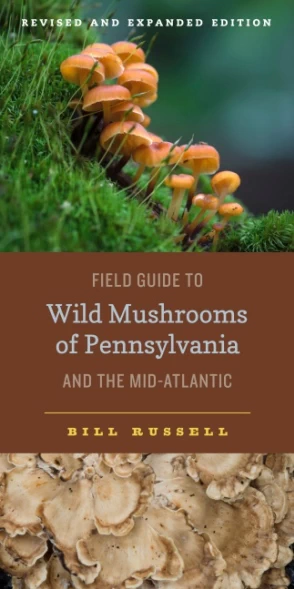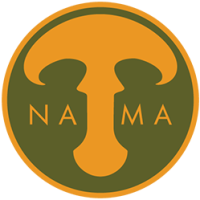The March-April 2007 issue of The Mycophile contained a review by John Plischke III of the first edition of Field Guide to Wild Mushrooms of Pennsylvania and the Mid-Atlantic. In short, he stated that there are a lot of advantages to having a field guide cover few enough mushrooms so as not to overwhelm a beginner, that he liked the convenient size (about 4½ × 9 inches) and the “In A Nutshell” summaries. Overall, he concluded that it was an excellent book for the novice and occasional mushroom hunter. I think Plischke’s comments were spot-on, and they apply equally to this revised edition.
The content is typical for a field guide, although the organization and presentation of the species accounts differ from that of most others. After the Preface and Acknowledgments, the introductory Mushroom Basics covers Identifying Features, Mushroom Love, Collecting and Identifying Mushrooms, Gathering Mushrooms, and Identifying Your Mushrooms by Name. Russell’s writing is clear, unpretentious and entertaining and he hits most of the points essential for a beginner. Missing, however, is mention of the ectomycorrhizal association when discussing how fungi make their living, and the figure showing the parts of a mushroom fails to include the lower portion of the stipe; as a result, there is no instructive illustration of the important-to-notice volva that occurs among species of the genus Amanita and a few other mushrooms. Mycophiles love fungi, not just mushrooms; mycologists study fungi, not just mushrooms. Also, it would have been good to provide a source for the claim that corn smut “may be poisonous when it matures and turns black.” I had not heard that before and would find it surprising, if true.
The bulk of the book consists of descriptions of 125 species of mushrooms, organized by season: Spring Mushrooms (16 species); Summer Mushrooms (75); Fall Mushrooms (23); and Winter Mushrooms (11). Handily, the seasonal sections are indicated by colored page-edge tabs. Within each section, the accounts are divided into Gilled (further divided by spore color), Neither Gilled nor Pored, Pored (Boletes) and Pored (Polypores). Most of the species accounts cover a page and a half to two pages. Each account starts with a photo, followed by the common name in a large font and, below that in a much smaller font, appear the scientific name (with authority) and suggested pronunciation of the Latin binomial. Unlike most guides, Russell first provides fairly lengthy commentary covering aspects of the particular mushroom he feels are most important or interesting and, often, some of his personal experiences with it. The commentary typically comprises more than half of the overall species account. It is followed by brief descriptions of the Cap, Hymenium (Gills, Pores, etc.), Spore Print, Stem, Growth Habit (including habitat and fruiting time), Edibility and a Tip. The 25-words-or-less In A Nutshell summaries appear in various locations as sidebars. The species included are nearly all common ones that appear in several other books.
The book is rather narrow (perhaps to fit in a pocket?) and so the photos are not very large, mostly 3 × 2¼ inches. Nearly all are of good quality and show the necessary features reasonably well. I enjoyed the commentary, as it provides a sense for the author and his personality that you can’t get from simple recitations of cap and stem dimensions and color descriptions. However, as in most guides, there are scattered errors and misstatements, among the more important of which are as follows: the main toxin in Amanita muscaria is ibotenic acid, not muscarine, which is present in very low concentrations (an important thing for medical personnel to know in the event of a poisoning); Cortinarius gentilis is not a deadly species (phylogenetic analyses show that it is a very close relative of C. brunneus, not of the orellanine-containing species such as C. orellanus); the discussion of lookalikes for the edible Leucoagaricus americanus (Lepiota americana) should include mention of amatoxin-containing Lepiota species such as L. subincarnata. Less critical issues include incorrect names: it’s Morchella americana, not M. esculentoides; Omphalotus illudens, not O. olearius (correct in some places, not in others); Cantharellus cibarius and Lactarius deliciosus appear not to occur in North America (we have several species that have been going under each of those names and gradually they are being recognized and given their own names); there’s no good evidence to suggest the fly agaric (Amanita muscaria) actually kills flies; the fertile tissue of boletes should be referred to as tubes, not “pores”; the “aborted entoloma” actually should be called the aborting entoloma, as the deformed blobs are primarily made of honey mushroom tissue; Suillus granulatus does not “grow almost anywhere evergreen trees grow in the United States” (it is primarily associated with pines and perhaps with a few other members of the Pinaceae, but certainly not with most evergreen conifer and broadleaved trees).
The book concludes with general discussions of Edible and Nonedible Mushrooms and Mushrooms in the Kitchen (including a handful of recipes), an Appendix listing the species by morphotype (gilled, pored, or neither of those), a short list of References and an Index (to both common and scientific names). Throughout the book, I was struck by the number of species that Russell claims that he and his friends consider to be good edibles and that they eat frequently — species that I rarely, if ever, hear anyone else praising, such as Agrocybe dura and Russell’s favorite edible, Clitocybe odora; either these Pennsylvanians are onto something the rest of the country is missing or they have a rather different sense of taste.
From a production standpoint, the book appears well put together with a flexible and seemingly durable cover, but it is notably very difficult to open and definitely won’t lie flat.
While I think that most any mushroomer would enjoy this book, I echo the sentiment of John Plischke III that it is best suited for beginners and outdoors folks with a passing interest in mushrooms. The species are ones that are likely to be widely encountered and there is a small enough number of them that people shouldn’t get overwhelmed.
Review by Steve Trudell, 2019


NAMA Store >